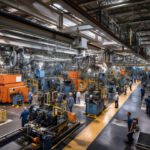Technological innovations are changing the face of manufacturing and maintenance. These technologies are helping companies maximize efficiency and effectiveness and make intelligent business decisions. The role of humans in these processes is changing as well, requiring skill sets that allow companies to fully utilize these digital tools. Here are four trends that are influencing business decisions in these sectors.
Mobile Communication
Mobile communication continues to grow in popularity across industries, including manufacturing and facilities maintenance. Mobile communication tools allow employees to collaborate and share information in real time, with no delay. Technicians and other employees out in the field have ready access to information like maintenance history or operating instructions when they need it, where they need it.
Mobile apps and tools also let employees enter information directly into systems such as Computerized Maintenance Management Systems (CMMS) or Customer Relationship Management (CRM) programs. Your team can add important details almost instantly, keeping your records accurate and up-to-date. Additionally, in an era when many companies are forced to run leaner and more dispersed teams, mobile communication tools are increasing productivity, helping organizations get more done with fewer employees.
Industrial Internet of Things (IIoT)
The expanded adoption of the Industrial Internet of Things (IIoT)is continuing across several sectors, including manufacturing and production asset management. Sensors in machines are connected to wireless networks that gather and share data and make the data available for analysis. Increased affordability of IIoT devices, expanding network options, and advancing big data analytics have combined to make it easier for companies of all sizes to start using IIoT in their operations, or to enlarge existing systems.
Companies are using IIot devices to collect data across many categories. Equipment conditions can be assessed using sensors that monitor vibration data, as well as through thermal imaging. Energy usage data is tracked to analyze trends and develop strategies to reduce energy usage and shift peak usage times to take advantage of off-peak energy rates. GPS monitoring on vehicle fleets helps companies efficiently deploy resources, as well as track usage and status of heavy equipment and other high-value assets.
Maintenance as a Service (MaaS)
The rise of cloud computing has led to more companies offering or utilizing Maintenance as a Service (MaaS) programs. You may be familiar with cloud-based maintenance services offered by some auto makers. In addition to delivering reminders for scheduled maintenance such as oil changes, these services track vehicle diagnostics and alert subscribers to more urgent or unexpected service needs. MaaS is a similar service for machinery and industrial equipment. MaaS systems collect data from sensors on equipment, then use the power of cloud-computing to analyze equipment conditions to develop predictive maintenance schedules and alert users to potential failures.
A variety of equipment vendors are offering MaaS programs for the machines they sell, and third-party vendors are offering MaaS for manufacturing and other industries. Both equipment vendors and third-party companies offer a spectrum of services within their MaaS products. Some of the services offered by MaaS vendors include maintenance service recommendations, maintenance training services for on-site staff, and even full maintenance operations management including technicians who perform the work.
Like many other cloud-based services such as asset management and data storage, MaaS are available as subscription services. This lowers the capital costs of on-site computing, shifting costs to monthly or operational expenses. The flexibility and scalability of MaaS make it affordable for organizations of all sizes. Companies pay only for what they need, and can easily adjust services to adapt to changing needs.
Workforce Trends
With near historic unemployment rates, the labor market is tighter than ever and the average time to fill an open position is increasing. The rate of retiring professionals is outpacing the number of new workers coming into the workforce. New workers joining the work force are often “digital natives” familiar with computers and other technology.
Traditional methods and skills are still needed in maintenance and manufacturing, but there is a growing shift to more digital and automated methods in the workplace. Knowledge of analytics and data interpretation are becoming more important as more companies adopt data-tracking solutions. Networking and telecommunication skills are also in demand as they are needed to build and maintain the systems that make cloud-based and other digital solutions possible.
Maintenance and manufacturing continue to adapt to a changing, interconnected world. Many companies are adopting technological solutions and skills to improve operations and stay competitive.
CMMS Software
Looking for a way to better manage your maintenance tasks? Our industry leading CMMS software will help you streamline your maintenance operations resulting in less equipment downtime, lower maintenance costs, and increased productivity. Learn more about our CMMS software today!








